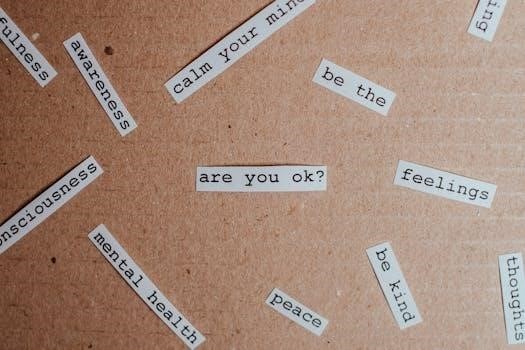Therapy Jenga⁚ An Engaging Therapeutic Tool
Therapy Jenga utilizes a classic game to foster communication. It involves answering questions written on blocks. This modified version aids in rapport building and exploring feelings. It proves beneficial for clients, especially those anxious about therapy. The game balances fun with therapeutic intent, and it is adaptable for various age groups.
Therapy Jenga is a creative adaptation of the traditional Jenga game, ingeniously designed to facilitate therapeutic conversations and interactions. Instead of simply removing and restacking wooden blocks, each block in Therapy Jenga is marked with a question or prompt. These questions are carefully crafted to encourage self-reflection, emotional expression, and open dialogue, making the game a valuable tool for therapists and counselors. The core concept remains the same, with players carefully removing blocks without toppling the tower; however, the added element of answering a question transforms the game into a dynamic therapeutic exercise. This approach helps to break down barriers, promotes engagement, and creates a safe space for clients to explore their thoughts and feelings. It also provides a playful yet structured way for therapists to gain insight into their clients’ perspectives, anxieties, and strengths. The questions can be tailored to suit various therapeutic goals, including building rapport, addressing specific emotional issues, or exploring personal values. Therapy Jenga is a flexible tool that can be used in individual and group settings across different age groups. It makes therapy more approachable and less intimidating, especially for those who find traditional talk therapy challenging.
Benefits of Using Jenga in Therapy

Utilizing Jenga in therapy provides a multitude of benefits, transforming a simple game into a powerful therapeutic tool. Firstly, it fosters engagement and reduces anxiety, particularly for clients who may be hesitant to participate in traditional talk therapy. The playful nature of Jenga creates a more relaxed and less intimidating environment, encouraging clients to open up more freely. The game also serves as an excellent icebreaker, helping to establish rapport between the therapist and client, or among group members. Furthermore, Jenga facilitates self-reflection and emotional expression as the questions on the blocks prompt clients to explore their thoughts, feelings, and experiences in a structured yet non-confrontational way. This process can lead to increased self-awareness and insight, which are crucial for personal growth. Additionally, Therapy Jenga enhances communication skills by encouraging clients to articulate their responses clearly and concisely. The interactive nature of the game also promotes active listening and empathy when used in group settings, as participants respond to each other’s answers; The game’s adaptable nature allows therapists to tailor the questions to address specific therapeutic goals or to focus on particular areas of concern, making it a versatile and effective therapeutic intervention.
Types of Questions Used in Therapy Jenga
The questions used in Therapy Jenga are diverse, spanning from lighthearted to deeply introspective, catering to various therapeutic needs. Simple questions, like “What is your favorite color?” or “What is your favorite holiday?”, are used to ease clients into the game and establish a comfortable atmosphere. More reflective questions, such as “What are three of your strengths?” or “What does love mean to you?”, prompt self-exploration and emotional awareness. Some questions are designed to encourage sharing of personal experiences, like “Talk about a time someone let you down.” or “Describe a time when you felt scared?”. There are also questions geared towards understanding specific emotions like “What do you do when you feel worried?” or “How do you handle anger?”. Questions may also be tailored to explore specific therapeutic themes or goals, such as coping mechanisms, personal values, or relationship dynamics. The flexibility of question types allows therapists to adapt the game to individual client needs, ensuring the therapeutic process is both effective and engaging. Additionally, the option to pass on a question ensures a safe and comfortable experience for the client.
Crafting Effective Jenga Questions
Crafting effective questions for Therapy Jenga requires a careful balance between open-ended inquiries and focused prompts. The goal is to create questions that elicit meaningful responses while remaining approachable for the client. Questions should be tailored to the individual’s needs, age, and therapeutic goals. It’s crucial to include a mix of question types, ranging from light and fun to more thought-provoking and introspective. Consider incorporating questions that encourage self-reflection, promote emotional expression, and facilitate rapport building. Avoid questions that are overly complex or may cause discomfort. Instead, aim for questions that are clear, concise, and easily understood. The use of “what,” “how,” and “why” can help prompt deeper thinking. For example, instead of asking “Are you happy?” ask “What makes you feel happy?”. Incorporating a variety of topics, such as personal experiences, values, and relationships, can provide a well-rounded experience. Ultimately, effective questions should be designed to support the therapeutic process, encouraging clients to explore their thoughts and feelings in a safe and engaging way. The therapist should always be prepared to adjust questions as needed based on the client’s reactions and progress.
How to Create a Therapy Jenga Set
Creating a Therapy Jenga set is a straightforward process that requires minimal materials. First, you’ll need a standard Jenga game, consisting of wooden blocks. Next, prepare your questions, either by writing them directly onto the blocks using a permanent marker or by printing them on labels to adhere to each block. If you choose to write, ensure your handwriting is clear and legible. Alternatively, if using labels, consider laminating them for added durability. You can also number each block to correspond with a list of questions you keep separate. This allows you to easily change the questions used, and to use different sets of questions for different needs. If laminating is used, mod podge, or another sealant can be used to ensure the labels are securely attached. Consider organizing questions into categories, such as feelings, relationships, or coping skills. This can help in targeting specific areas during therapy. Once you’ve prepared the blocks, stack them as you would for a normal Jenga game. Your Therapy Jenga set is now ready for use in therapeutic sessions. Remember to store it in a secure location to prevent damage.
Adapting Jenga Questions for Different Age Groups
Adapting Jenga questions for different age groups is crucial for effective therapeutic use. For younger children, questions should be simple, concrete, and focused on basic emotions and experiences. Examples include “What is your favorite color?” or “What makes you happy?” Visual aids, such as pictures representing emotions, can also be included on the blocks. For tweens and teens, questions can become more complex, exploring relationships, identity, and challenges. Consider prompts like “What is a quality you like about yourself?” or “What is a challenge you are facing?”. For adults, questions can delve into deeper topics such as life goals, values, and personal growth. Examples might include “What does success mean to you?” or “What is something you would like to change about your life?”. Regardless of the age group, it’s important to provide a safe and non-judgmental space. Always ensure the questions are age-appropriate, culturally sensitive, and tailored to the specific needs of the individual or group. The therapist should also be prepared to modify questions if they are not well-received or if a client is uncomfortable.
Using Jenga for Rapport Building

Using Jenga as a rapport-building tool is an excellent way to initiate conversation and create a comfortable environment. The game itself is engaging and familiar, which can ease initial anxieties clients might have about therapy. The element of play and shared activity helps break down barriers and encourages interaction. By incorporating questions that are lighthearted and non-threatening, such as “What is your favorite hobby?” or “What is your favorite animal?”, therapists can establish a sense of connection and understanding. As the game progresses, the questions can gradually become more personal, allowing clients to share information at their own pace. This approach is particularly beneficial for clients who are hesitant to talk or have difficulty opening up. The collaborative nature of Jenga also fosters a sense of teamwork and can reduce power dynamics between therapist and client. It is vital to create an atmosphere of safety where clients feel comfortable sharing their thoughts and experiences. The focus should remain on fostering connection, understanding, and building a foundation of trust through the enjoyable engagement of Jenga.

Jenga Therapy in Group Settings
Jenga therapy is exceptionally effective in group settings, offering a unique dynamic that promotes interaction and shared experiences. When used in a group, Jenga can help participants develop a sense of camaraderie and mutual understanding. The act of taking turns and engaging with questions encourages active listening and empathy among group members. Questions can be tailored to address common themes or challenges within the group, fostering a supportive environment where individuals feel comfortable expressing themselves. The collaborative nature of the game allows members to learn from each other’s perspectives and build a sense of community. It can also help break down social barriers and encourage participation from even the most reserved individuals. Facilitators can use the game as a platform to initiate discussions and explore more profound topics, creating a space for open dialogue and mutual support. Furthermore, the shared experience of playing Jenga can reduce feelings of isolation and create a positive atmosphere within the group. The focus is on creating a therapeutic space where members can connect, learn, and grow together through the shared experience of play and conversation.
Variations and Creative Adaptations

The versatility of Jenga therapy allows for numerous variations and creative adaptations, making it a highly flexible tool for therapists. One popular adaptation involves using different categories of questions on the blocks, such as emotional check-ins, coping strategies, or personal values. Another variation includes color-coding the blocks, with each color representing a different type of question or activity. Some therapists have incorporated physical actions with the questions, such as acting out a scenario or performing a simple movement. The game can also be adapted to include art therapy elements, where participants are asked to draw or express themselves artistically in response to a question. Additionally, some therapists have created themed Jenga sets focusing on specific issues like anxiety, relationships, or self-esteem. To further enhance engagement, some incorporate music or storytelling prompts into the Jenga game, adding another dimension to the therapeutic process. The possibilities for variations are endless, allowing therapists to tailor the game to meet the unique needs and goals of their clients. This adaptability ensures that Jenga remains an engaging and effective therapeutic tool across different populations and settings.
